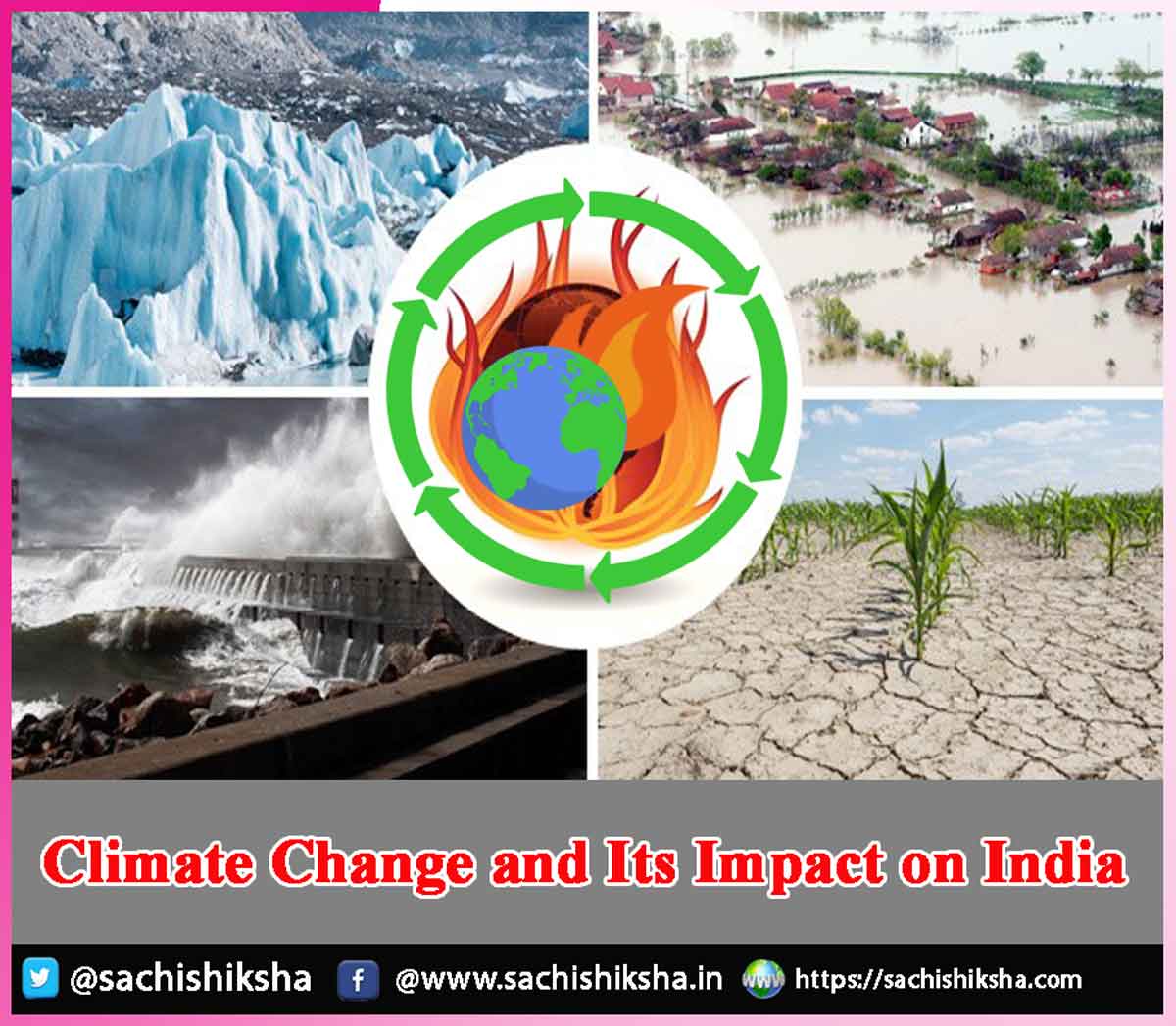Climate Change and Its Impact on India
Introduction: Climate change is one of the most pressing global challenges of the 21st century, with far-reaching consequences for the environment, human health, economic development, and geopolitical stability. It refers to long-term changes in temperature, precipitation patterns, sea levels, and weather events. While the phenomenon is global, its effects are often more severe and immediate in developing countries like India, which are more vulnerable due to their geography, population size, and limited adaptive capacity. India, home to over 1.4 billion people, is already experiencing the adverse impacts of climate change, which threaten its food and water security, health systems, biodiversity, and economic growth.
Table of Contents
Causes of Climate Change in India
Climate change in India, like elsewhere, is primarily driven by the increase in greenhouse gas (GHG) emissions, including carbon dioxide (CO₂), methane (CH₄), and nitrous oxide (N₂O). Key contributors include:
- Industrialization and Urbanization: Rapid industrial growth and urban expansion have significantly increased energy demand, much of which is met by fossil fuels like coal, oil, and gas.
- Deforestation: Forests act as carbon sinks, absorbing CO₂ from the atmosphere. In India, deforestation due to agriculture, infrastructure development, and illegal logging has reduced this capacity.
- Agricultural Practices: Methane emissions from rice paddies and livestock, as well as nitrous oxide from the excessive use of fertilizers, contribute to India’s greenhouse gas emissions.
- Transportation: The expansion of the road network and rising vehicle ownership, particularly in urban areas, has led to increased emissions from the transportation sector.
Evidence of Climate Change in India
India is already witnessing several signs of climate change. These include:
- Rising Temperatures: According to the Indian Meteorological Department (IMD), India’s average temperature has increased by approximately 0.7°C between 1901 and 2018. Heatwaves are becoming more frequent, prolonged, and intense.
- Erratic Monsoons: The Indian monsoon, vital for agriculture and drinking water, is becoming increasingly unpredictable. There are reports of both delayed onset and sudden withdrawal, affecting crop yields.
- Melting Glaciers: The Himalayan glaciers, which feed major rivers like the Ganges and Brahmaputra, are retreating rapidly, threatening long-term water availability.
- Sea-Level Rise: Coastal areas such as Mumbai, Chennai, and the Sundarbans are at increased risk of flooding and erosion due to rising sea levels.
Impact on Agriculture
Agriculture is the backbone of India’s economy, employing nearly 60% of the population. However, it is highly climate-sensitive. Key impacts include:
- Reduced Crop Yields: Erratic rainfall, rising temperatures, and extreme weather events have led to a decline in the yields of staple crops such as rice, wheat, and pulses.
- Water Scarcity: With depleting groundwater and irregular monsoons, irrigation becomes difficult, further affecting crop production.
- Increased Pests and Diseases: Warmer temperatures facilitate the proliferation of pests and plant diseases, reducing productivity and increasing dependency on pesticides.
- Farmer Distress: Economic losses due to crop failure have increased indebtedness among farmers, contributing to social issues like migration and even suicides.
Impact on Water Resources
India’s water resources are under immense stress due to both climatic and anthropogenic factors:
- Glacial Melt and River Flow: The melting of Himalayan glaciers impacts river systems, initially increasing water flow and causing floods, followed by long-term reductions in river discharge.
- Groundwater Depletion: Rising temperatures increase evaporation rates and reduce groundwater recharge, leading to water shortages in many regions.
- Urban Water Crisis: Cities like Bengaluru and Chennai have faced acute water shortages, made worse by erratic rainfall and poor water management.
Impact on Health
Climate change poses significant health risks in India:
- Heat-Related Illnesses: Rising temperatures have led to increased cases of heatstroke, dehydration, and cardiovascular diseases, particularly among vulnerable populations.
- Vector-Borne Diseases: Warmer temperatures and changing rainfall patterns extend the range of mosquitoes, leading to outbreaks of malaria, dengue, and chikungunya.
- Air Pollution: Climate change exacerbates air pollution, especially in urban areas, leading to respiratory issues, asthma, and reduced life expectancy.
- Mental Health: Climate-related disasters such as floods, droughts, and heatwaves can lead to stress, anxiety, and trauma
Impact on Biodiversity
India is one of the world’s 17 megadiverse countries, but climate change is threatening its rich biodiversity:
- Habitat Loss: Rising temperatures and shifting rainfall patterns are altering habitats, pushing species to migrate or face extinction.
- Marine Ecosystems: Coral reefs, particularly in the Andaman and Nicobar Islands, are experiencing bleaching due to warmer sea temperatures.
- Species Extinction: Iconic species like the Bengal tiger and Indian elephant are at risk as their habitats shrink and water sources dry up.
Impact on Coastal Areas
With a coastline of over 7,500 kilometers, India’s coastal regions are highly vulnerable:
- Flooding and Erosion: Rising sea levels and more intense cyclones lead to coastal erosion, salinization of groundwater, and loss of infrastructure.
- Impact on Livelihoods: Millions of people depend on fishing and tourism along the coasts. Climate change threatens these livelihoods through declining fish stocks and damaged ecosystems.
Socio-Economic Consequences
Climate change exacerbates existing inequalities:
- Poverty and Inequality: The poor are the most vulnerable, with limited resources to adapt or relocate. Climate-induced migration is already occurring in parts of India.
- Food Security: Reduced agricultural productivity and supply chain disruptions impact food availability and prices, hitting the poor hardest.
- Energy Demand: Higher temperatures increase energy demand for cooling, straining the power infrastructure and leading to frequent outages.
Government Initiatives and Policy Response
India has taken several steps to address climate change:
- National Action Plan on Climate Change (NAPCC): Launched in 2008, it outlines eight missions, including the National Solar Mission, National Mission on Sustainable Agriculture, and National Water Mission.
- State Action Plans on Climate Change (SAPCCs): These tailor national objectives to regional needs.
- Renewable Energy Push: India has committed to achieving 500 GW of non-fossil fuel capacity by 2030. The country is one of the global leaders in solar energy.
- International Commitments: India is a signatory to the Paris Agreement and has pledged to reduce the emissions intensity of its GDP by 33-35% from 2005 levels by 2030.
- Afforestation Programs: Campaigns like “Green India Mission” aim to expand forest cover and enhance carbon sinks.
Challenges in Tackling Climate Change
Despite the efforts, several challenges remain:
- Implementation Gaps: Policies often lack effective execution due to bureaucratic delays and inadequate funding.
- Public Awareness: Climate literacy is low, and behavior change among the public is slow.
- Balancing Growth and Sustainability: As a developing nation, India must balance economic development with environmental protection, which often leads to trade-offs.
Conclusion
Climate change is no longer a distant threat for India; it is a present reality that affects millions of lives. From declining agricultural yields to rising sea levels, from erratic monsoons to health crises, the impacts are wide-ranging and deeply interconnected. While the Indian government has initiated several policies and programs to mitigate and adapt to climate change, a more comprehensive and inclusive approach is needed. This includes strengthening institutional capacity, increasing public awareness, promoting sustainable practices, and fostering international cooperation. The time to act is now—before the window to limit catastrophic consequences closes forever.














































